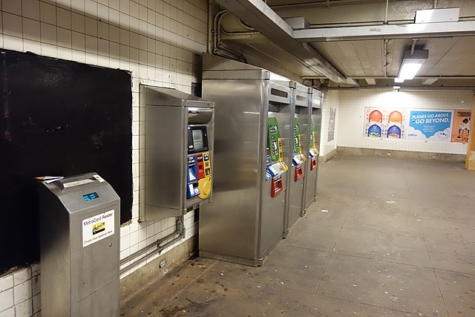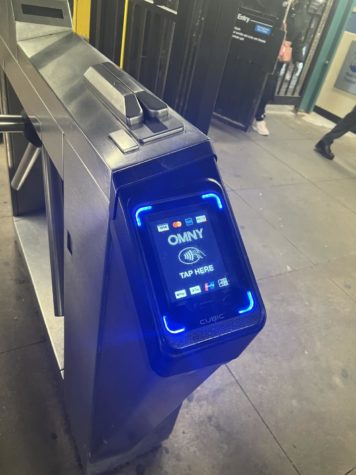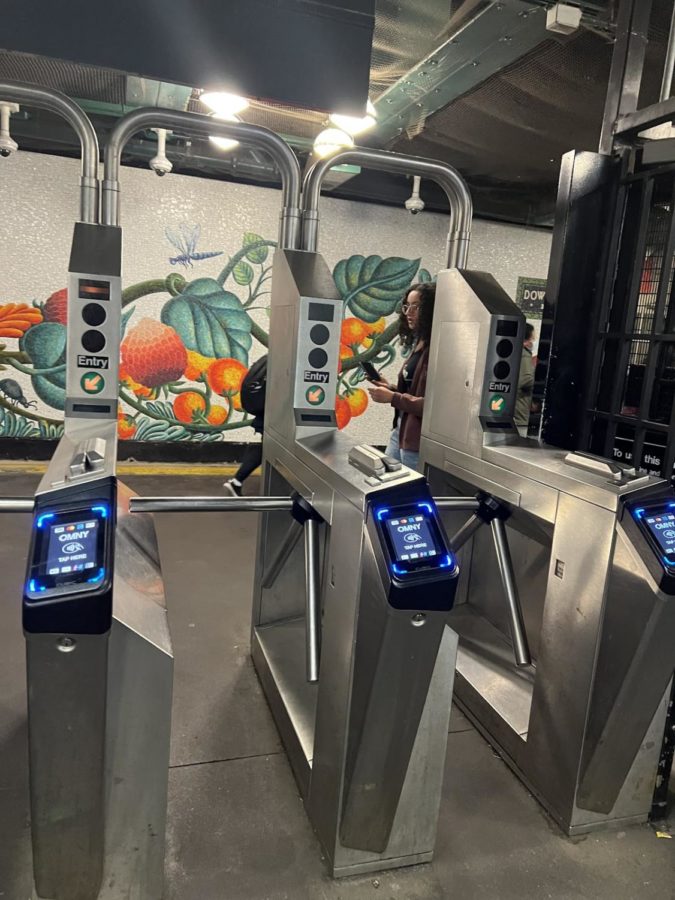The End of the Line – Say Goodbye to New York City’s Iconic Yellow MetroCards
With the installation of the new OMNY readers in NYC’s subway stations, commuters are seeing the end of the iconic yellow MetroCard.
Commuters can now pay their fares by tapping on OMNY readers, as seen at the Number 4 train Bedford Park Boulevard Station near Bronx Science.
Rushing down the avenue past slow walkers, one hears the honking of cars and sees the city lights fade in the background. The smell of the subway is prominent, getting stronger as the station gets closer. Your adrenaline is high; the train is arriving in a minute.
There is a certain type of run that a person takes down the stairs in an effort to catch the train, all the while struggling to take the yellow MetroCard out to swipe through the turnstiles. There’s a satisfactory feeling when the swipe works the first time. The screeching of the train alerts commuters of its arrival. The announcement “Stand clear of the closing doors, please,” sounds overhead, as New Yorkers rush into the train to grab a seat. This is the reality of around 3.1 million daily riders of the New York City subway. However, this reality is about to change.
Most people have seen, heard, or even used one of New York City’s iconic yellow MetroCards. Every Metropolitan Transportation Authority (MTA) commuter has used one. It has become a staple of the New York City identity and a prominent symbol throughout New York City.
However, all good things must come to an end. The iconic MetroCard machines that have been a part of the New York City subway stations since 1999 are going to be phased out in “the not-so-distant future,” starting in September 2022, according to a tweet by the MTA.

What is OMNY?
OMNY, or One Metro New York, was officially launched in May of 2019 and has since reached 500 million “taps.” Instead of swiping their MetroCard, commuters can simply tap their credit or debit cards or a phone with digital wallets – such as Apple Pay and contactless credit, debit, and reloadable prepaid cards – on the OMNY reader as they enter the station. Patrick Foye, the CEO of the MTA, claims it is more convenient for riders, plus more environmentally-friendly.
Going Green
OMNY is being seen as a solution to combat the large amounts of waste being dumped into the streets of New York. MetroCards are one of the many pieces of litter often found on subway floors.
“I don’t usually take the subway, but when I do, I have seen yellow MetroCards lying on the subway station floor just getting stepped on. Even on the trains, I’ve seen maybe one or two MetroCards on the floor just lying there,” Sydney Lee ’23 said.
The plastic used to make MetroCards cannot be recycled. The MTA has tried combating this wasteful cycle by adding a $1 charge to newly purchased MetroCards in order to encourage riders to refill their existing cards, but they have had little to no success, as MetroCards continue to scatter the floors of subway stations and transit centers. OMNY is seen as the solution to combating this dilemma, as it requires no plastic cards. It is just a simple tap on the machine.
MetroCard Setbacks
Not only are MetroCards environmentally-costly, but they are also a huge waste of money. In 2011, WNYC reported that lost and unused MetroCards across the city add up to $52 million annually. This is wasted money coming straight out of commuters’ pockets.
MetroCards are also not very efficient. Many commuters have experienced the constant frustration of swiping and re-swiping at the turnstile because the card would not read. This is especially frustrating when students are running late for school.
Senior Council President Anny Chen ’23 has a similar story with this experience.
“The one day I accidentally slept in is the one day my train decides to run on time. I was busy shuffling my things to grab my student MetroCard from my bag. I was swiping at the turnstile and walked through, except it didn’t go through. Frustrated, I swiped again. “Please Swipe Again” was displayed on the machine. I swiped again. Nothing. Usually I get it on the first try! I felt the line of people behind me getting frustrated and moving to the other turnstiles. I was stressed. My train was arriving in two minutes, and the machine wasn’t working. So after three more tries, I gave up and went to the next machine. The same thing happened! I looked around, and it was apparently just me struggling to swipe. So I tried the last machine. It finally worked! So after swiping in, finally, I ran to my train and barely made it before the door closed. This is just a typical New York City high school student experience,” Chen said.
There is also the refill issue. Sometimes when paying for MetroCards, credit cards can be declined for incorrect zip codes, even if the person entered the right one. At most subway stations, there is at least one machine that doesn’t work, decreasing efficiency.
The OMNY Plan
The MTA started a marketing program called “Tap On, Get On,” to help educate New Yorkers on how the OMNY process works.
For those who do not have a smartphone, they will be able to purchase an OMNY card at retail locations like CVS/Walgreens and vending machines located inside subway stations. They will also be available to purchase with cash, for those without credit cards. The MTA has also begun to introduce reduced fares for senior customers and riders with disabilities.
Future plans for the OMNY readers include implementing them in the Metro-North Railroad and the Long Island Rail Road (or the LIRR). On the OMNY information website, customers traveling on LIRR or Metro-North will have access to a new mobile ticketing experience in the OMNY mobile app. More information about this future development is set to be provided in the coming months.
As an avid LIRR user, Faryll Jaffee-Lakatos ’23 said, “I usually use the app to buy my tickets. I’m not sure how they’re going to implement this new system, but I’m glad they are technologically advancing.”
OMNY Reactions
The MTA first made the announcement of implementing the OMNY system in late 2020. Now, New York City’s iconic MetroCard machines will be removed from subway stations; the full switch-over from MetroCard machines to OMNY vending machines will take place by the end of 2023.
Even though the new method is seemingly more efficient, the news was met with mixed reactions by regular New York City subway commuters at Bronx Science.
Some students grew up with the MetroCards and are saddened by the news of it being replaced. “I’ve been using the student MetroCards since middle school. I can’t imagine not having one,” said Griffin Weiss ’24.
As of right now, students are using the free Student MetroCards, which are provided by the MTA and distributed by individual schools, that offer three free rides on the city’s buses, subways and the Staten Island Railway each day between 5:30 a.m. and 8:30 p.m. However, with the new OMNY system, the MTA is planning to issue contactless Student OMNY Cards for the 2023-2024 school year pending successful software development and testing, meaning this could be the last year student’s need to swipe or dip their cards.
Others are concerned about how this new technological innovation could impact their fellow New Yorkers.

New York City has a history of homelessness and it is not rare to see them in subway stations or on the trains. The new OMNY reader is a limitation towards them and the elderly, who may have issues accessing this new technology.
“I am a little apprehensive about the change because as much as I am all for technology, this is a system that’s been in place for decades, and many of the New Yorkers who use the system don’t have the resources readily available to them to use OMNY,” said Stephan Chirinian ’25.
Despite this backlash, there has been positive feedback from students in response to the OMNY system.
“Paying with my phone not only makes the entire process easier, but it also makes me feel happy knowing I’m participating in new age technology,” said Daniel Addoquaye ’23.
Other students have a neutral stance on the new system.
“I personally love how accessible it is and how easy it is to use, especially since I forget my MetroCard a lot. However, I think phasing out MetroCards is a bad idea because I think they’re cute,” said Mary Dimyan ’23.
New Yorkers always seem to be in a rush to go somewhere. With this new OMNY system, Patrick Foye, the CEO of the MTA, said “OMNY is designed to save New Yorkers’ their most precious commodity — their time.”
“I’ve been using the student MetroCards since middle school. I can’t imagine not having one,” said Griffin Weiss ’24.
Aaminah Bukhari is a Copy Chief for ‘The Science Survey.’ Her job is to edit her fellow peers’ articles to help them display their full writing potential....

